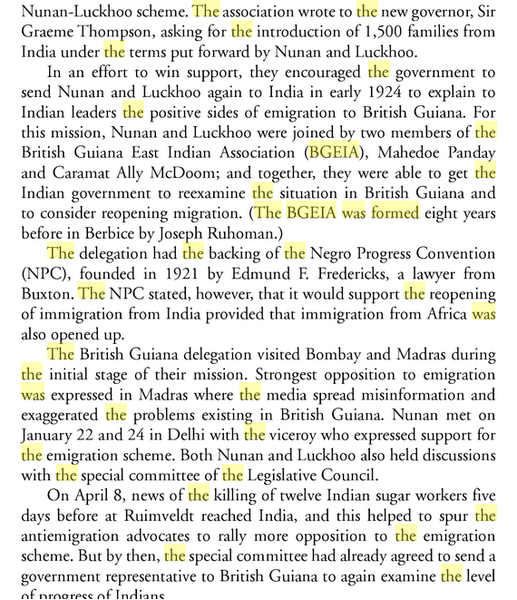Ravi Dev
http://www.landofsixpeoples.co...ws702/nk0705206.html
"Take the ending of Indian indentureship in 1917. The event marked the beginning of a new era in more ways than one, and not only for Indians. Up to this juncture, while there had been opposition from Africans and Coloureds to the introduction of Indians into Guyana , the opposition had focused on the inequity, to the Creole population, of bringing in competition in labour - and partially at their expense. Now the opposition would be pitched at much higher stakes – the highest - political control of the country.
After the cessation of Indian indenturship, the planters still desired new Indian immigrants – for all the same reasons that had “justified” the old system. However, in 1919, to preclude criticisms based on the old excesses, they proposed a system of indentureship that would involve settling large numbers of Indians immigrants as independent farmers, after they served a three-year contract.
J.A. Luckhoo, (solicitor and first Indian member of the Legislature) and a group of Indians re-launched the BGEIA in Georgetown in April 1919, after it had lapsed since its formation in Berbice in 1916. Mr. Luckhoo and Dr. Hewley Wharton, the first Indian doctor in Guyana , were authorised, on behalf of the BGEIA, to convince the Indian authorities of the feasibility of the scheme.
They reached India in 1919-20 but opposed by Gandhi and others, they failed. However as part of the rationale to convince their Indian audience, they offered that their aim was “to induce more Indians from the motherland to join our ranks, increase our numbers and so help us make British Guiana an Indian Colony.”
In reaction to this assertion, which precipitated the inchoate concerns of the African/Coloured leadership, the Negro Progress Convention (NPC) was formed on Aug. 1st 1922. Hubert Nathaniel Critchlow, the noted labour leader, was a founding member of the Convention, which took an aggressive stand against the Colonisation Scheme. But since they advocated that if necessary, workers should also be imported in equal numbers from Africa, it was obvious, even if they did not state it explicitly, that they were concerned about the strategic implications of the Africans and Coloureds becoming a minority in Guyana .
The question of local political control of the state – tilted in favour of the non-Indian middle class by the 1890 Constitution - was now rising on the agendas of the two major ethnic groups. In 1921, the Indians were just about 42% of the population while Africans were 39% and Coloured – 10%. Even though universal franchise was not even on the horizon, an Indian majority would have meant profound changes for those who expected to inherit power – the Coloured and African elite.
In 1923-24, J.A. Luckhoo and Nunan (Attorney General) visited India once again to get the Scheme approved and this time they were successful. The NPC and BGLU, however, were determined to derail this initiative. Francis Kawall, President of the BGEIA at this point, and some others in the BGEIA, were now also bitterly opposed to the scheme.
The record shows that from 1919 to 1924 the sugar workers on the East Bank had been in touch with Critchlow (and in 1924 with both Critchlow and Kawall) about their labour grievances. The NPC had petitioned the Colonial Office on the Colonisation Scheme with their concerns about any increased Indian population. The petition adumbrated most of the arguments that would be used against Indians in the following decades, down to the present, about the African Ethnic Security Dilemma.
The Scheme was a “distinct act of discrimination” against Blacks who were entitled to ‘first consideration' since they were the ‘pioneer settlers' of British Guiana . Additionally, the scheme “would tend to rob (Blacks) of their political potentialities, as they would be the minority in any voting contest – the Indian vote would become more than or equal to the votes of any two of the other sections of the community; it would be detrimental to good government and the preservation of the peace…”
_______________________________________________________________






